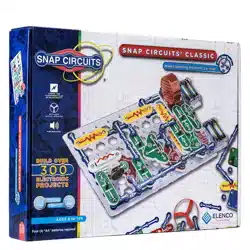Loading ...
Loading ...
Loading ...

41
Project #109
Build the circuit, then connect points Y & Z (use a 2-snap wire) for a moment.
Nothing appears to happen, but you just lled up the 470mF capacitor (C5) with
electricity. Now disconnect Y & Z and instead touch a connection between X & Y.
The green LED (D2) will be lit and then go out after a few seconds as the electricity
you stored in it is discharged through the LED and resistor (R2).
Notice that a capacitor is not very efcient at storing electricity - compare how long
the 470mF kept the LED lit for with how your batteries run all of your projects! That is
because a capacitor stores electrical energy while a battery stores chemical energy.
Make Your Own Battery
OBJECTIVE: To demonstrate how batteries can store electricity.
Project #111 Make Your Own Battery (III)
In the preceding circuit, replace the 470μF capacitor (C5) with the 100μF
capacitor (C3) and repeat the test. You see that the LED (D2) goes out faster,
because the 100μF capacitor does not store as much electricity as the 470μF.
Now replace the 1kW resistor (R2) with the 100W resistor (R1)
and try it. The LED (D2) gets brighter but goes out faster because
less resistance allows the stored electricity to dissipate faster.
Project #110
Make Your Own Battery (II)
Project #112
Turn on the slide switch (S1) for a few seconds, then turn it off. The
green LED (D2) is initially bright but goes dim as the batteries (B1)
charge up the 470mF capacitor (C5). The capacitor is storing electrical
charge.
Now press the press switch (S2) for a few seconds. The red LED (D1) is
initially bright but goes dim as the capacitor discharges itself through it.
The capacitor value (470mF) sets how much charge can be stored in it,
and the resistor value (1kW) sets how quickly that charge can be stored
or released.
Capacitor Charge &
Discharge
OBJECTIVE: To show how capacitors store and release
electrical charge.
Loading ...
Loading ...
Loading ...
